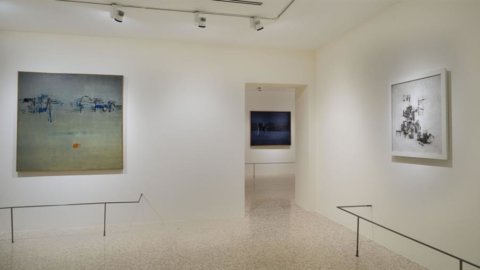With over 40 paintings and works on paper from the most important public institutions and private collections in Asia, Europe and the United States, this is the first ever retrospective dedicated to the Indian artist Vasudeo Santu Gaitonde (1924–2001). With an artistic career unparalleled in the history of modern Southeast Asian art, Gaitonde's work presents an unprecedented opportunity to explore the modern Indian art that characterized the metropolitan centers of Bombay (now Mumbai) and New Delhi from the second half of the 40s to the end of the 24th century. Venice is the second stage of the exhibition, previously presented at the Solomon R. Guggenheim in New York (2014 October 11 – 2015 February XNUMX).
VS Gaitonde was an artist of exceptional stature, known to artists and intellectuals of his era, as well as to scholars and collectors of the following generation, for his absolute integrity of spirit and purpose. Born in Nagpur, India, throughout his career he remains an independent painter, despite the fact that in the early 50s he approaches the avant-garde collectives of Bombay. The exhibition at the Peggy Guggenheim Collection traces the stages of his artistic career, from the first figurative compositions in mixed technique, to the watercolors inspired by Paul Klee, passing through the canvases of the 60s and 70s that most distinguish him, up to the last works of the 80s and 90s. Starting with Klee, towards the end of the 50s his work became increasingly non-representative, indeed, to use his words, non-objective. His turn towards abstraction echoes the artistic principles expounded by Vasily Kandinsky and on which the very origin of the Guggenheim in New York as the Museum of Non-Objective Painting is based, also matching with Gaitonde's own interest in Zen Buddhism, its ethics and creative practice.
Short, a little stocky, self-critical, but also self-confident, Gaitonde rejects sentimentality, in life as in art. As the painter Krishen Khanna states "There is a very strong link between the way Gaitonde thought and lived and the way he painted". In addition to art, Gaitonde loves Indian vernacular poetry, international cinema, literature and theatre, Western classical music, Eastern philosophical thought systems. Strongly believing in the importance of the present moment and in the intimacy of the relationship between the painter and the painting, the career of "Gai", as he was called by his colleagues, an intrepid and influential artist, has no equal in the history of modern art of the South Asia. Nonetheless, his career remains little studied in the history of XNUMXth-century art.
Featuring many never-before-seen works that have never been shown to the public before, the exhibition reveals Gaitonde's extraordinary use of line, form and surface treatment, as well as the use of symbolic elements and calligraphy, in works that shine with their own light. .
Although the genesis of his works could last months, Gaitonde accepts that chance and play become part of the final result. In the early 60s he began to create abstract forms through a process of "removal", first using palette knives and rollers and then torn pieces of newspapers and magazines. The works take on a great lightness, despite their materiality asserting their physicality. In the mid-60s Gaitonde went to New York, thanks to a scholarship offered by Rockefeller, and here he was immortalized by photographer Bruce Frisch in his studio at the Chelsea Hotel in January 1965. A part of these shots, rarely exhibited, they will be on display at the Peggy Guggenheim Collection on the occasion of the exhibition, in digital format.
A series of sources and influences of an international nature constitute the historical context for Gaitonde's work, thus also defining the itinerary of the exhibition itself. Her work crosses the traditions of non-objective painting, Zen Buddhism, Indian miniatures, Far Eastern calligraphy scrolls and ink paintings. While Gaitonde is nonetheless representative of his era and therefore some similarities can be observed with artists from the School of Paris and the Informal, Tachisme and Abstract Expressionist movements, his work is defined by the ethos of his homeland, where he lives and works all his life.
During the opening period of the exhibition, between October and January 2016, there will also be a cycle of four appointments for people, adults and children, blind and visually impaired, but also sighted, who will be able to take part in guided tactile itineraries linked to some of the exhibited works. The project, conceived by Valeria Bottalico, and accompanied by workshop activities conducted by the blind sculptor Felice Tagliaferri, enjoys the support of The Gordon and Llura Gund Foundation. Finally, there will also be Sunday Kids Days, educational workshops for children aged 4 to 10 inspired by the exhibition itinerary, and free guided tours open to the public every day at 15.30pm. The educational projects related to the exhibition are realized thanks to the Araldi Guinetti Foundation, Vaduz.
VS Gaitonde. Painting as a process, painting as a life benefits from the support of a Leadership Committee. A special





